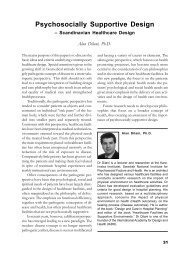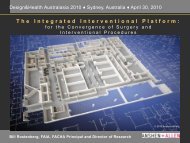Medical Research and its Impact on Healthcare Design - the ...
Medical Research and its Impact on Healthcare Design - the ...
Medical Research and its Impact on Healthcare Design - the ...
Create successful ePaper yourself
Turn your PDF publications into a flip-book with our unique Google optimized e-Paper software.
MEDICAL RESEARCH AND ITS IMPACT ON HEALTHCARE DESIGNfects. Some new methods based <strong>on</strong> cell biological<str<strong>on</strong>g>and</str<strong>on</strong>g> immunological basic science can alsobe expected to be used in clinical trials within aclose future.• Surgery. No decrease can be seen. The reas<strong>on</strong>sfor this is mainly that <strong>the</strong> large groupsof cancer in <strong>the</strong> ventricle, intestine <str<strong>on</strong>g>and</str<strong>on</strong>g> lungwill be treated similarly as 30 years ago <str<strong>on</strong>g>and</str<strong>on</strong>g> nosignificant <strong>the</strong>rapeutic progress is at sight.• Radiati<strong>on</strong>. A promising development of prot<strong>on</strong>-radiati<strong>on</strong><strong>the</strong>rapy is taking place.• Cytotoxic drugs. The research studying <strong>the</strong>cellular factors of importance for <strong>the</strong> sensitivityof <strong>the</strong> drug is progressing rapidly. The resultsof this will make it possible to individualise<strong>the</strong>rapy at different tumour c<strong>on</strong>diti<strong>on</strong>s,which will give better <strong>the</strong>rapeutic results <str<strong>on</strong>g>and</str<strong>on</strong>g>fewer side effects.• Antibody <strong>the</strong>rapy. The development of methodsto interfere with adhesi<strong>on</strong> molecules<strong>on</strong> <strong>the</strong> surface of <strong>the</strong> cancer cell will make itpossible to create drugs that will slow down<strong>the</strong> progress of metastasis.• Autologue <str<strong>on</strong>g>and</str<strong>on</strong>g> analogue b<strong>on</strong>e-marrow transplantati<strong>on</strong>.In combinati<strong>on</strong> with cytotoxicdrugs this technique will be used for treatmentof tumours which can’t be cured today,e.g. malignant melanomas <str<strong>on</strong>g>and</str<strong>on</strong>g> solid tumourssuch as cancer of <strong>the</strong> col<strong>on</strong> <str<strong>on</strong>g>and</str<strong>on</strong>g> breast cancer.• Gene <strong>the</strong>rapy. Large investments are made todevelop this technique for clinical purposes.It will be used <strong>on</strong> <strong>the</strong> <strong>on</strong>e h<str<strong>on</strong>g>and</str<strong>on</strong>g> to replacea defect gene which will cause cancer, <str<strong>on</strong>g>and</str<strong>on</strong>g><strong>on</strong> <strong>the</strong> o<strong>the</strong>r to modulate <strong>the</strong> expressing of<strong>on</strong>co-genes <str<strong>on</strong>g>and</str<strong>on</strong>g> supressor genes. The latterform of <strong>the</strong>rapy means a new strategy forcancer preventi<strong>on</strong> <str<strong>on</strong>g>and</str<strong>on</strong>g> treatment. Ano<strong>the</strong>rpromising form of <strong>the</strong>rapy involves blockingof <strong>the</strong> an gio genesis.• Substantial improvements in <strong>the</strong> <strong>the</strong>rapy ofdifferent forms of cancer in children; cancerin <strong>the</strong> lymphatic system, testis cancer <str<strong>on</strong>g>and</str<strong>on</strong>g> cancerof <strong>the</strong> urinary bladder.The new methods of tumour <strong>the</strong>rapy willin <strong>the</strong> future have a profound impact <strong>on</strong> <strong>the</strong>structural changes of <strong>the</strong> systems for <strong>the</strong> care<str<strong>on</strong>g>and</str<strong>on</strong>g> nursing of patients suffering from cancer.Therapy for diseases in <strong>the</strong> heart <str<strong>on</strong>g>and</str<strong>on</strong>g> bloodvesselsFundamental changes are taking place with regardto <strong>the</strong> treatment of different circulatorydisorders. The new <strong>the</strong>rapeutic methods willresult in fewer inpatients at <strong>the</strong> hospitals <str<strong>on</strong>g>and</str<strong>on</strong>g>a better quality of life for a larger number ofpatients. Some trends are summarised below.• Surgery of <strong>the</strong> heart <str<strong>on</strong>g>and</str<strong>on</strong>g> blood vessels. Newless invasive technologies are developed.The “BIG” open surgery in <strong>the</strong> thorax <str<strong>on</strong>g>and</str<strong>on</strong>g><strong>the</strong> brain will gradually be replaced by “ca<strong>the</strong>ter-based”techniques including PTCAin cor<strong>on</strong>ary vessels <str<strong>on</strong>g>and</str<strong>on</strong>g> introducti<strong>on</strong> of“stents” in narrow vessels.• Technologies for revascularisati<strong>on</strong> will beimproved (stents; ultrasound; laser, highspeeddrills). Also more serious damages of<strong>the</strong> vessel or l<strong>on</strong>g-lasting occlusi<strong>on</strong>s will betreatable. Transplantati<strong>on</strong> of endo<strong>the</strong>liumwill be used.• Treatment of heart failure. A rapid developmentof new types of drugs is taking place(e.g. ACE inhibitors; peptide horm<strong>on</strong>es).These new drugs will reduce <strong>the</strong> number ofin patients.• Treatment of stroke. The future will see less“classical” rehabilitati<strong>on</strong> <str<strong>on</strong>g>and</str<strong>on</strong>g> more early, aggressivetreatment with e.g. TPA <str<strong>on</strong>g>and</str<strong>on</strong>g> streptokinaseafter thrombosis <str<strong>on</strong>g>and</str<strong>on</strong>g> drugs thatprevent <strong>the</strong> progress <str<strong>on</strong>g>and</str<strong>on</strong>g> expansi<strong>on</strong> of <strong>the</strong>tissue damage after a haemorrhage. Acuteneuroprotective treatment will include <strong>the</strong>use of cal cium-channel antag<strong>on</strong>ists; GABAantag<strong>on</strong>ists <str<strong>on</strong>g>and</str<strong>on</strong>g> antag<strong>on</strong>ists against glutamate.• Methods to prol<strong>on</strong>g <strong>the</strong> survival time forcells that have been exposed to hypoxia in<strong>the</strong> brain or <strong>the</strong> myocardium will be develo-43
















